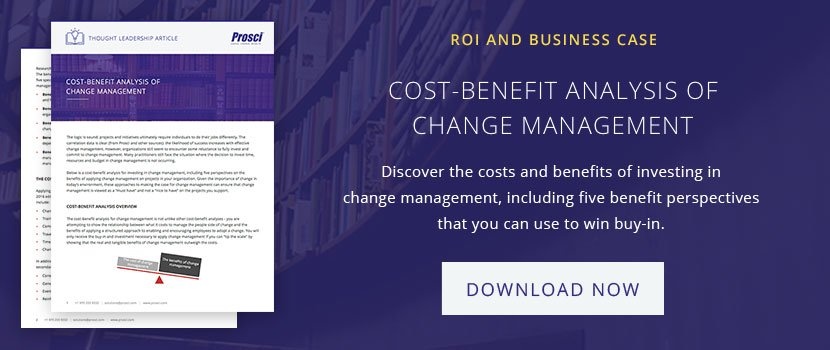Creating a Compelling Business Case

5 Mins
Updated: August 10, 2022
Published: September 5, 2015

The business case is more than just the numbers - it tells the story of your project. As you get ready to enter 2006, you will need to be able to make a compelling case - with both hard and soft 'Rs' - to get the funding and support you need for projects to be successful.
Business Case Basics
Why should a business case be written?
The most obvious reason for putting together a business case is to justify the resources and capital investment necessary to bring a change project to fruition. However, this implies that the business case is simply a financial document. While all business cases should include financial justification, it should not be the only purpose of the document.
The business case is the one place where all relevant facts are documented and linked together into a cohesive story. This story tells people about the what, when, where, how and why.
- Why is the project needed (issues & opportunities)
- How will the effort solve the issues or opportunities facing the organization
- What is the recommended solution(s)
- How does the solution address the issues or opportunities (benefits)
- What will happen to the business if the BPR effort is not undertaken (the do nothing scenario)
- When will the solutions be deployed
- How much money, people, and time will be needed to deliver the solution and realize the benefits
What are the three roles of a business case?
The writing of the business case forces the team to sit back and reflect on all of the work they have so diligently completed. It is far too easy for the team to continue to plug away toward the end result and fail to document the work they've already accomplished. This is especially true during the concept and design stages of any project. Therefore, the business case serves as a wake-up call to the team causing them to capture the knowledge they've developed about how the business will function both with and without the final solution.
The second role of the business case is to verify that the solution substantiates or meets the needs of the business, and is the vehicle for receiving funding and approval to move forward. It provides a vehicle for the team to step back and subjectively review their facts and assumptions. In addition, it is vital that the team document what would happen to the business if the project is not undertaken. This base case or "do nothing" scenario is the foundation upon which all benefits from the effort are derived. By documenting everything together in one story, it is easy to link the issues to the solution and the benefit, and identify where the business would be without the project. The development of the overall business case simplifies the development of the financial justification, and will usually identify holes or problems with the solution. Moreover, you now have a way to measure your success. This analysis also is useful for your leadership team to prioritize this project against the many other initiatives in the business that may require capital investment.
The final important role that the business case plays is to provide a consistent message to many different audiences. It is a high level view of the entire project and enables all organizations affected by the effort (customers, management, operations, research & development, service, sales, accounting, finance, etc.) to be knowledgeable about the project.
Goals and benefits
While one of your primary goals may be to get funding, your chances of success will be greater if you keep the following goals in mind as well:
- Make it interesting; remember someone will have to read it
- Keep it clear and concise
- Minimize jargon and conjecture
- Communicate all facts as part of the overall story - you've done your homework, here is the chance to prove it
- Provide the reader with a picture or vision of the end state
- Demonstrate the value the project brings to the organization, customer and financial bottom line of the company
The benefits obtained by your team by writing the business case are many, but at a minimum they will have gained:
- Organization of thoughts, activities and knowledge
- An objective review of the ideas and facts of the project
- The ability to identify holes, inconsistencies or weaknesses in the effort
- An improved ability to communicate the purpose of the project
- Financial justification for their effort
- A great sense of accomplishment
Elements of the Business Case
Background
Your business case tells the story of your project. It should tell the reader the problem or opportunity that exists. Then, the business case should describe how the problem will be solved or the opportunity exploited. Although the financial elements are critical, they are in no way the only important parts of the business case. The outline presented below shows you how to effectively tell the entire story of your project and concludes by demonstrating the expected ROI and financial impact you expect. The Business Case Toolkit provides complete description, guidelines, tips and examples for each of the sections presented in this outline.
Executive summary
The executive summary should be the first section of the business case, but it is the last section that is written. It is a short (one to three pages) summary of the entire business case. Pretend you have two minutes to tell someone about the project and justify your requests for resources and funding. The executive summary is this two-minute drill.
Each section in the executive summary should succinctly convey vital information about the project, and communicate the entire story to the reader. The information for each section of the executive summary is extracted from the detailed sections of the business case that you have just completed.
Situational (or current state) assessment and problem statement
The situational assessment (or current state assessment) is the details regarding the problem or opportunities facing the organization. It is a statement about what is happening in your organization today. Most projects are started by the original project stakeholder or champion because something is wrong, or a major opportunity is being missed. Every project usually has one or two key themes related to issues or opportunities.
Project description
The project description section introduces your reader to the details of the project. This section should give your stakeholders confidence that your team will professionally, efficiently and aggressively seek the best processes, systems, and organizational elements to enable your company to overcome the issues presented above. There are two main components of the project description: description and scope objectives
Solution description
The solution description section summarizes the solution that your team recommends to address the issues and opportunities presented in the situational assessment. The solution description should be written in the following order:
- Concept overview
- Solution detail
- Sub-project structure
- Solution alternatives
Note: refer the Reengineering Design Toolkit for vision development and solution design guidelines.
Cost and benefit analysis
After the current state assessment, project description and solution design, the reader is now likely to ask, "What is the cost to get to the future state, and is it worth it?"
This section will provide the answer to that question. A successful business case is not complete without a thorough analysis of the costs and benefits associated with implementing the proposed solution. But remember, determining the costs and benefits can be difficult.
Implementation timeline
Now that management understands the solution and the financial return that will be realized from implementing the solution, they will want confirmation that the solution can actually be implemented.
This section will reassure management that your team has carefully and professionally considered all major issues of the implementation. A number of major elements are important to successful implementation. Your implementation section should address each area.
- Implementation components
- Implementation timeline
- Major milestones
- Major dependencies
Critical assumptions and risk assessment
Most business improvement projects will make assumptions in order to develop the solution. It is vital that the business case documents these assumptions. You should test your assumptions with project stakeholders and operational managers prior to placing them in the business case. The statement of assumptions should be followed by an impartial discussion of the strengths, weaknesses, opportunities and threats (SWOT) that are associated with the recommended solution. Finally, it is also important that the business case discuss the risks associated with both implementing and not implementing the solution. In other words, the key issues associated with going forward with the solution.
Conclusions and recommendations
This section brings closure to the business case. It should reiterate the key themes that caused the project to be undertaken. It should restate the solution in at a high-level. It should identify the return on investment and the overall benefits of the solution. It should restate the risks of doing nothing and re-convey a sense of urgency. Finally this section should state the conclusions the reader should draw from the business case, and your recommendations for next steps.


